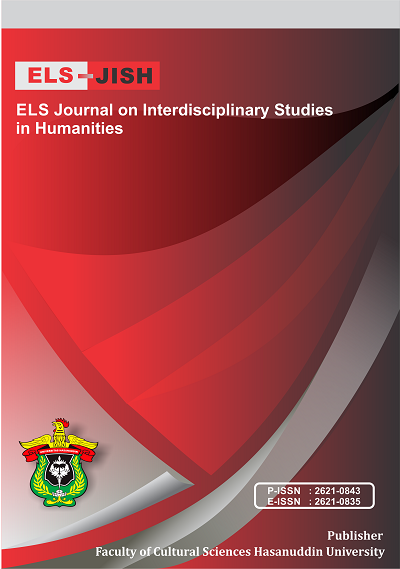Metaphorical Expression in the Song Lyrics of Album Evermore by Taylor Swift
DOI:
https://doi.org/10.34050/elsjish.v7i2.35163Keywords:
Lyrics of songs, Metaphorical meanings and expressions, The album EvermoreAbstract
This study aims to identify the metaphorical terms included in the lyrics of Taylor Swift's album "Evermore." Using the theoretical framework offered by Lakoff and Johnson—which highlights the impact metaphorical language has on listeners' perception and comprehension—the study focuses on analyzing these metaphorical statements. The results show that Swift uses a wide range of metaphorical terms to describe both universal and particular experiences, which heightens the emotional impact and relatability of her songs. By highlighting the critical role that metaphor plays in modern song lyrics and providing insights into how metaphorical language can elicit strong imagery and emotional resonance in listeners, this study makes significant advancements in the discipline of linguistic pragmatics. Through an in-depth analysis of contemporary music, the research underscores how songwriters skillfully utilize metaphors to convey complex emotions, experiences, and narratives that might be difficult to express through literal language alone. This not only enriches the listeners' interpretative experience but also enhances their emotional connection to the music.
References
Adam, M., Rahman, F., Abbas, H., & Sahib, H. (2024). Corpus-Based Diachronic Study of WAR Metaphor in Indonesian Political Discourse. International Journal of Religion, 5(7), 515-523.
Andini, C., Yassi, A. H., Sukmawaty. (2021). The use of honorifics in English and Buginese with special reference to bone language: A comparative study. International Journal of Innovative Science and Research Technology, 6(7), 873-877.
Chomsky, N. L. (1957). Syntactic Structures. Walter de Gruyter
Creswell, J. W. (2014). Research Design: Qualitative, Quantitative, and Mixed Methods Approaches. SAGE Publications.
Firuz, Rahman, F., & Amin, M. A. (2022). Authors’ Figurative Expressions From Two Novels: A Comparative Analysis Between RTJNA Rosso and RTJNA Blu. Theory and Practice in Language Studies, 12(1), 150-157.
Julich-Warpakowski, N., & Pérez Sobrino, P. (2023). Introduction: Current challenges in metaphor research. Metaphor and the Social World, 13(1), 1-15.
Kövecses, Z. (2023). Metaphor and discourse: A view from extended conceptual metaphor theory. In The Routledge Handbook of Discourse Analysis (pp. 170-183). Routledge.
Lakoff, G., & Johnson, M. (1980). Metaphors We Live By. University of Chicago Press.
Panggabean, W. (2018). Deictic Expressions in Nasreddin's Selected Stories. Balikpapan: Balikpapan University.
Saleh, F., Rahman, F., & Hasyim, M. (2021). Metaphor in the Bugis language expression of the Sidenreng dialectin South Sulawesi. International Journal of Arts and Social Science, 4(1), 312-318.
Song, Y., Zhang, W., & Xu, J. (2023). Study on Anhui Image Communication Strategies from Cognitive Perspective of Multimodal Metaphor and Metonymy:--A Case Study of Anhui Global Promotional Video. Academic Journal of Management and Social Sciences, 5(1), 125-130.
Sukmawaty, S., Andini, C., & Rahman, F. F. (2022). The Shift of Honorifics due to The Promotion As A Government Official: Comparative Study. ELS Journal on Interdisciplinary Studies in Humanities, 5(1), 166-176.
Youngsun, K., Sosrohadi, S., Andini, C., Jung, S., Yookyung, K., & Jae, P. K. (2024). Cultivating Gratitude: Essential Korean Thankfulness Phrases for Indonesian Learners. ELS Journal on Interdisciplinary Studies in Humanities, 7(2), 248-253.
Yule, G. (1996). Pragmatics. Oxford: Oxford University Press.
Downloads
Published
Issue
Section
License
Copyright (c) 2024 Waladdin Panggabean, Nofansyah Nofansyah

This work is licensed under a Creative Commons Attribution-ShareAlike 4.0 International License.






